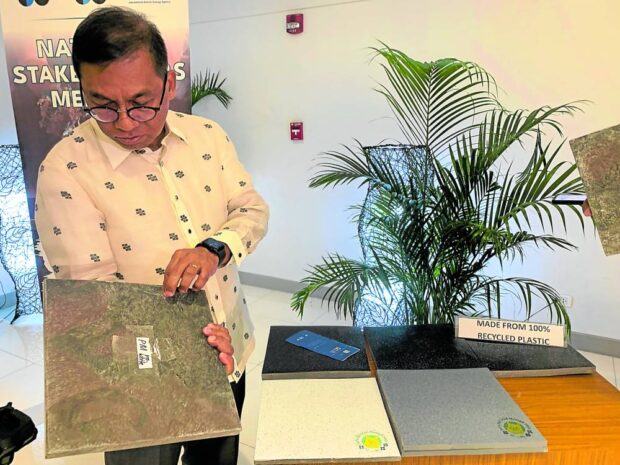DOST sees ‘nuclear solution’ vs plastic pollution

ECOFRIENDLY | Science Secretary Renato Solidum Jr. shows the eco-friendly “plastic tiles” developed by the Department of Science and Technology using radiation technology. (Photo by JANE BAUTISTA / Philippine Daily Inquirer)
MANILA, Philippines — The Department of Science and Technology (DOST) is introducing what it calls a “nuclear solution” to help combat the worsening plastic pollution problem in the country.
When people talk about nuclear, the first thing that often comes to mind are bombs, according to Dr. Carlo Arcilla, director of the DOST’s Philippine Nuclear Research Institute (PNRI).
At the sidelines of the high-level National Stakeholders Meeting on Monday attended by scientists and representatives of the International Atomic Energy Agency (IAEA), Science Secretary Renato Solidum Jr. showcased eco-friendly plastic tiles made of recycled plastic waste.
The tiles made of mixed or comingled municipal plastic waste were developed under the Post-radiation Reactive Extrusion (PREx) research initiative of the PNRI with the help of the DOST’s Industrial Technology Development Institute and its private business partner Envirotech Waste Recycling Inc.
The initiative is also in line with the Philippines’ participation in the NUTEC Plastics Project of the IAEA, which supports the use of nuclear and radiation technologies for environmental and industrial development.
Article continues after this advertisementMany benefits
Arcilla explained that the radiation technology “manipulates the behavior of polymers in plastic” so it creates stronger bonds and, in turn, creates stronger materials.
Article continues after this advertisementBased on one of the findings of the research team, the raw materials, composed of mixed municipal waste with polypropylene and other types of polyethylene or materials used in plastic packaging, “yielded stronger and slightly more rigid materials” with radiation intervention.
Project leader Dr. Jordan Madrid said they observed a 15-percent increase in flexural or bending strength compared to the untreated samples.
“With natural fiber reinforcement using abaca, we produce stronger and more flexible materials,” he added.
Through irradiation, certain types of plastic waste could be modified for recycling by altering the structures of the material and enabling its different components to blend better, according to the PNRI.
This resulted in a new product that was stronger, more dense, and with enhanced properties, the agency said.
The creation of the construction material also reduced the emission of greenhouse gases and chemicals that could be harmful to the environment, added Solidum.
With the introduction of a new innovation, he said it was like “hitting several birds with one stone” because it would address the problem of plastic pollution and at the same time provide for the need for new materials for construction work.
“Our planet is facing a historic disaster — the epidemic of plastic waste — and the Philippines is at the forefront,” Solidum lamented.
Among biggest polluters
The Philippines ranks as the world’s third biggest polluter with 2.7 million metric tons of plastic waste generated each year, but the country has very limited facilities for recycling single-use and low-value plastics.
The PREx project, the PNRI said, was intended to produce a viable technology that would complement existing recycling and reuse capacities while also managing plastic waste in support of the extended producer responsibility law.
Solidum said the DOST and its attached agencies were not just developing a proof of concept as they also plan to do a pilot test of the materials next year.
The pilot study would look into the effectiveness of the products and how their operation could be supported, particularly in sourcing the plastic waste supply.
“What will be the role of the people for example and the LGU (local government unit)? If we segregate our waste, will the local governments be able to supply the industries who will initiate these kinds of upcycling activities?” Solidum asked.
He underscored the importance of reaching out to possible industry partners in building more irradiation facilities that would develop the material.
Aside from upcycling the plastics, he said the radiation technologies could also be used in agricultural crops for sterilization to ensure that there would be no insects when the products are exported.
“Nuclear energy has different applications. People think that nuclear energy is only for power generation like the Bataan Nuclear Power Plant or small modular reactor. But that view is very narrow because nuclear energy could be used in agriculture like in mutation that develops new species,” he said.